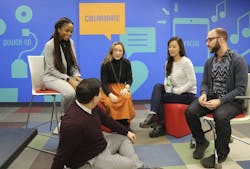Behind the whiteboard: Collaborative spaces set teachers up for classroom success
Teachers spend countless hours creating an environment for students to thrive in. Students are not the only ones who benefit from a supportive school culture. As lifelong learners, teachers need spaces to develop too. The teachers at Grant Avenue School in New York recognized this, but with 464 students and a busy schedule, there was little space for opportunities to learn from each other. Fortunately, there was 500 square feet of underutilized space in an old science storage room. The room was transformed from storing books and science equipment to become an active hub where colleagues share ideas and experiences.
The transformation began when the not-for-profit organization Change for Kids connected with Hillmann Consulting and Gensler to create a place for the teachers to call their own. The organization was already working with the teachers to maintain a strong culture. The project was familiar territory for the design team. Through initiatives like EDU 2.0 and Community Impact, Gensler supports not-for-profit institutions with volunteer activities, pro-bono projects, mentorship, and other activities that give back to the community.
The teachers’ dedication was clear from the beginning when they shared their experience in a visioning session. Their mission is to create the best setting for their students—no matter the time and energy it takes. A community of empowered educators translates to inspired students in the classroom. Research shows motivation plays a critical role in guiding the direction and quality of learning behaviors in students. (How Learning Works, S. Ambrose). The space simultaneously benefits teachers and students.
Image © Gensler.
Known as the Teacher coLab, the rejuvenated space takes inspiration from academic incubators in higher education. The programming elements are just as applicable in an elementary school setting. Collaborative spaces like this help educators come together to share knowledge and enhance their skills. The multifunctional space facilitates think tanks, coworking areas, and acts as a forum for knowledge exchange between colleagues.
The design supports teachers throughout their day in four zones. Each functions for a specific behavior in the program. The “Power Up” zone offers a pantry to connect around with colleagues. The “Collaborate” zone provides tables and writable surfaces for meetings and team-based learning. The “Focus” zone helps teachers reflect and have time to themselves. The “Unwind” zone is a living-room style space where teachers engage in thought-provoking conversations in a more relaxed environment.
It is important to combine school spirit and comfort in teacher-centered spaces. The space features bright accent colors and engaging brand elements to offer a respite from the loud corridors and busy classrooms. Today, Grant Avenue teachers power up before the first bell rings, exchange ideas with colleagues, complete lesson plans, and relax—all in one place.
Small interventions and dedicated programming better prepare schools to have a positive experience for both students and teachers. Designers may provide guidelines on how to use the room, but in the end, teachers make the space their own to bring new ideas back into the classroom.
